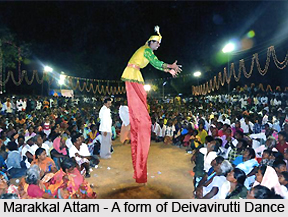 Deivavirutti is a kind of dance which is a collective form of eleven dances put together. The association of music and dance with rituals is well attested to. The concept of panan is now rarely heard of. Groups, orchestral accompaniment, theatre and royal patronage are in evidence. The Kadalatu Kathai of Silappathikaram refers to eleven varieties of dance collectively known as Deivavirutti (associated with deities).
Deivavirutti is a kind of dance which is a collective form of eleven dances put together. The association of music and dance with rituals is well attested to. The concept of panan is now rarely heard of. Groups, orchestral accompaniment, theatre and royal patronage are in evidence. The Kadalatu Kathai of Silappathikaram refers to eleven varieties of dance collectively known as Deivavirutti (associated with deities).
Performance of Deivavirutti Dance
Certain deities are praised, and the evil ones decried on the strength of mythological representations of the deities. Atiyarkkunallar, the commentator supplements the information available in the epic by listing the variety: (i) Kodukatti: Lord Shiva`s triumphal dance after destruction of Tripura by fire, (ii) Pandarangam: Dance of Lord Shiva to delight Lord Brahma, (iii) Alliyam: Praise to Lord Krishna on his slaying Kamsa (iv) Maletal depicts Lord Krishna and Balarama`s wrestling combat with Kamasa`s emissaries, (v) Tudi: Murukan`s dance over the fall of Surapadman, (vi) Kutaikuttu: Murukan`s dance over the victory on asuras (Avunar), (vii) Kudakkuttu: Lord Krishna`s amorous dance before Vanasura to secure the release of Aniruddha, (viii) Pedu: Lord Krishna`s son dances in the costume of an eunuch to divert the attention of Vanasura, (ix) Marakkal: Asuras get frustrated while battling with Koravai. They attack her with scorpions and snakes. Koravai wears wooden legs (marakkal), (x) Pavai: Goddess Lakshmi dances to enchant Vanasura and to enter his fort, (xi) Kadayam: Dance of Indrani at the northern gates of Vanasura`s fort (Indrani`s dance poses are drawn from Vatsyayana`s Kamasutra).
Vettiyal was the dance enacted at royal courts and dance varieties intended for commoners were called Poduviyal. Dancers were expected to be proficient in the 64 arts which included garland making, floor decoration, literacy, composition and picture painting. Different kinds of body movements, limb movements, poses, gestures, keeping of time-beats, manipulation of vocal chords and allied techniques were taught.
This article is a stub. You can enrich by adding more information to it. Send your Write Up to content@indianetzone.com



















